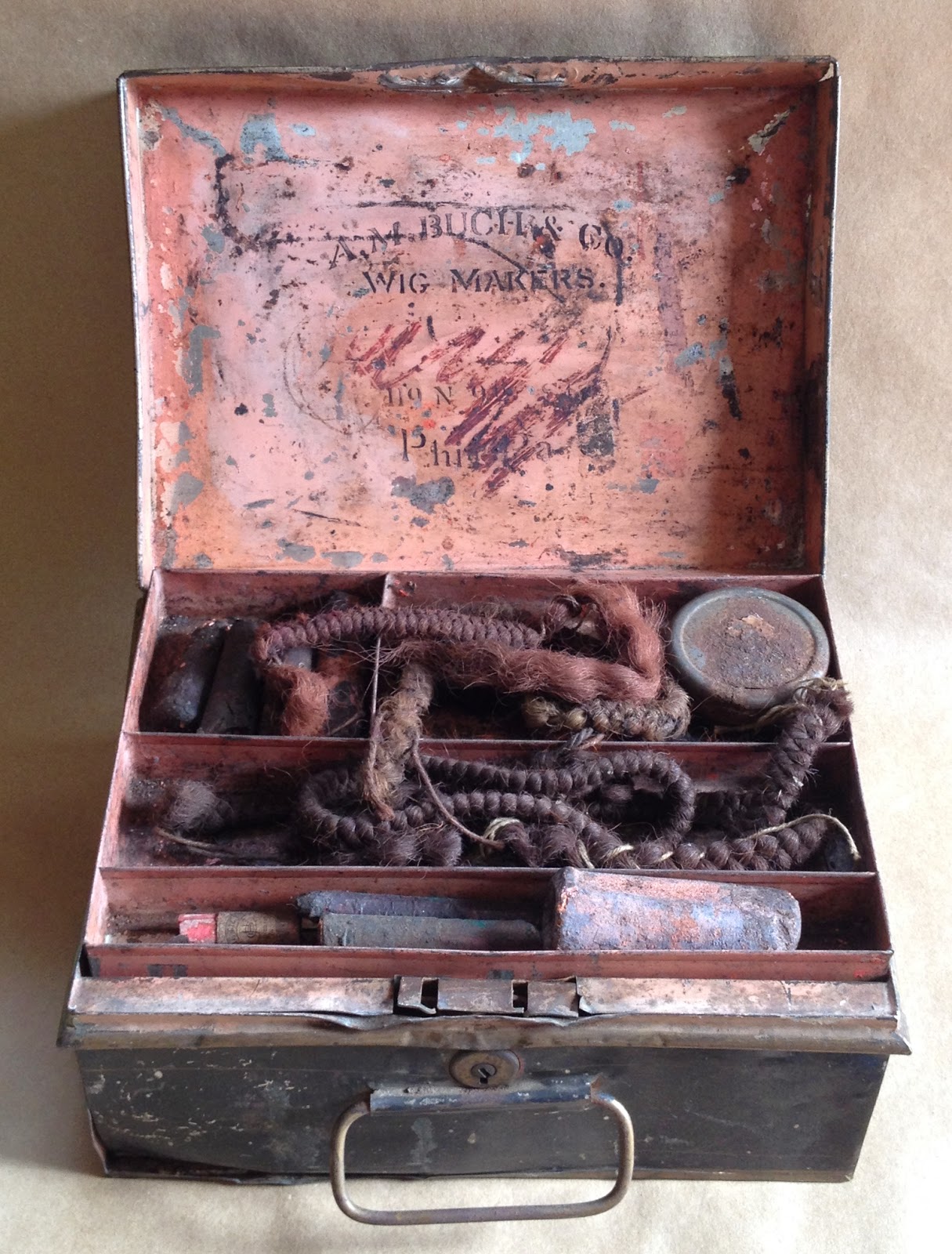 |
| "Our Special Make-up Box," Circa 1890 Stenciled label reads: A.M. Buch & Co./WIG MAKERS./119 N. 9th Street/PHILADELPHIA |
This gem was made by A. M. Burch & Co., based at 119 N. 9th Street in Philadelphia. Described as "Our Special Make-up Box" in its 1890 trade catalogue I read thanks to The Athenaeum of Philadelphia, the original would have come stocked with the following:
"Heavy Black Tin, with tray, separate compartments, with Yale Lock and two keys. 70 cents a piece. The Actor's Make-up Box. A handsome decorated tin case containing the various article commonly used in 'making up' for the stage; will answer all ordinary requirements of any actor. It contains a set of Face Paints (9 colors) Light Flesh and Dark Flesh Face Powder. Powder-puffs, Hares foot, Cold Cream, Dry Rouge, Nose Putty, Grenadine Lip Rouge, Spirit Gum; Moustache Cosmetique; Black Wax, 2 camel's hair pencil's, 2 shades of Water Cosmetique, a light and a dark, with a brush for applying them. Mirror, scissors and an assortment of crepe hair. Price complete $4.00."
 |
| Contents of wig box bottom |
 |
| Assorted wig box contents |
I can't tell for certain what's inside each of the tins. Some tins that remain inside this box are empty, others contain black lumps of mystery makeup.
Another handbook, Charles Harrison's 1882 Theatricals and Tableaus Vivants for Amateurs, noted that, after the mid-nineteenth century, more and more plays featured contemporary characters. Makeup, therefore, became a more important part of the costume when the actor could not rely on recognizable historic-looking objects to represent specific historical figures (pirates, soldiers, prostitutes, etc.). As a result, making-up manuals and makeup trade catalogues, which seem to cater to amateur actors in particular (though not exclusively), emphasized creating the "right" skin shades or marks of age. Whether or not this was all true is unclear, but these writers and makeup manufacturers were certainly good marketers!
 |
| "Conventional Types," from James Young, Making Up (1905) |
Back in 2010, I hemmed and hawed about whether or not to snatch this up. What would I do with rotting stage makeup? The box sits silent and shut on a shelf in my office, but it has character, and it evokes a good time. It's also a good artifact to use for care and handling training. (In this case, be sure to wear gloves when handing unknown substances!) Back in 1890, Burch advertised it as his "special" makeup box. It's now my special makeup box, dirt, grease, and all.
What else can I ask for in an antique?
When I first made this purchase, I promised you all I'd blog about a mystery object in "the coming weeks." It looks like I meant "coming years," as I'm just getting to this now. I hope it was worth the wait.
Anyone have any late nineteenth-century stage makeup ephemera out there? I'd love to learn more about collecting historic theatrical makeup!

My great-grandfather, Charles N Harlowe, owned a drug store at 46th and Broadway in NYC from 1917 to 1926. Years ago, while digging through the family stuff (to use George Carlin's phrase), I found a box of linseed and a notation for using it as a base for theatrical make-up. Apparently quite a few actors bought their supplies at Harlowe's store. See his obit, NY Times, Nov 15 1934, p. 21. Also there was a story in Variety about the store's closing but I can't find the citation.
ReplyDeleteVery cool! Thanks for sharing your family's history.
DeleteThe mystery makeup is Burnt Cork, which is crushed and mixed into a paste with water to make an easy to remove Blackface makeup. The little wiggly braids are Crepe Wool for making false beards. They are in the braids because you can use them as is for a kinky style beard, or steam it straighter for average or straight beard hair. There was also a way to mix it with spirit gum to build up a false nose (but the how-to of that I've never found). The other tins once contained cold cream, powder, & pressed powdered rouge. The one thing in the kit I don't recognize the use for is the grayish stick of soapstone (?). Most kits like this also have grotty little paper tortillons for applying lines. You can see photos of some of my old kits I've studied for information here: http://andrewkahn.me/wiki/ClassesMakeupclassOldkits1
ReplyDeleteLoved your article and photos - I found this post looking for information about the company - I also have one of these wig makers boxes :-)
ReplyDeleteMine had a few items inside too. Have had it on a shelf for about 20 years........